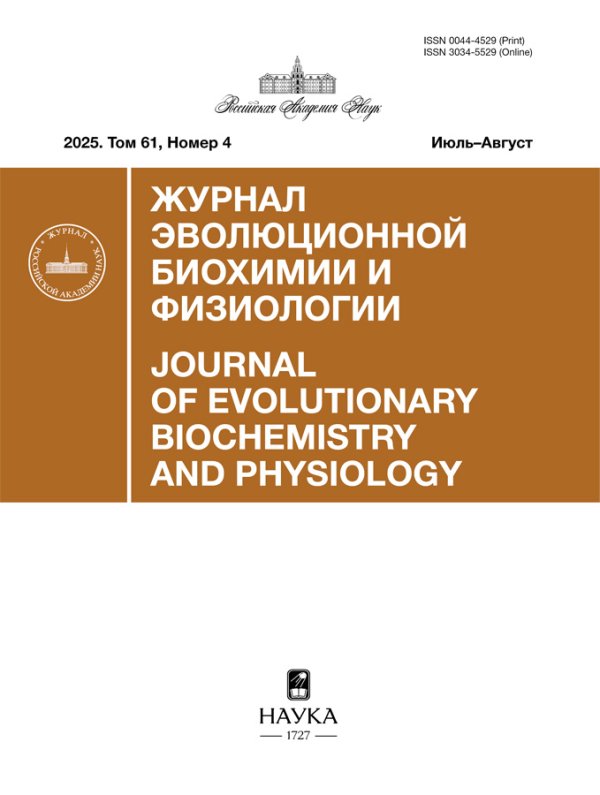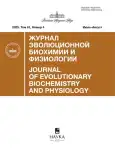Возможные пути и механизмы воздействия слабых переменных магнитных полей на когнитивные функции Drosophila melanogaster
- Авторы: Медведева А.В.1, Щеголев Б.Ф.1, Сурма С.В.1, Токмачева Е.В.1, Никитина Е.А.1,2, Савватеева-Попова Е.В.1
-
Учреждения:
- Институт физиологии им. И.П. Павлова РАН
- Российский государственный педагогический университет им. А.И. Герцена
- Выпуск: Том 61, № 4 (2025)
- Страницы: 251-259
- Раздел: ЭКСПЕРИМЕНТАЛЬНЫЕ СТАТЬИ
- URL: https://stomuniver.ru/0044-4529/article/view/697056
- DOI: https://doi.org/10.7868/S3034552925040041
- ID: 697056
Цитировать
Полный текст
Аннотация
Ключевые слова
Об авторах
А. В. Медведева
Институт физиологии им. И.П. Павлова РАНСанкт-Петербург, Россия
Б. Ф. Щеголев
Институт физиологии им. И.П. Павлова РАНСанкт-Петербург, Россия
С. В. Сурма
Институт физиологии им. И.П. Павлова РАНСанкт-Петербург, Россия
Е. В. Токмачева
Институт физиологии им. И.П. Павлова РАНСанкт-Петербург, Россия
Е. А. Никитина
Институт физиологии им. И.П. Павлова РАН; Российский государственный педагогический университет им. А.И. Герцена
Email: 21074@mail.ru
Санкт-Петербург, Россия; Санкт-Петербург, Россия
Е. В. Савватеева-Попова
Институт физиологии им. И.П. Павлова РАНСанкт-Петербург, Россия
Список литературы
- Jain N, Shedpure M, Tikariha R, Karanjgaonkar P, Ratre M, Agniwanshi S(2015) Magnetic field effect on biological systems. Indian Journal of Life Sciences 5(1): 135–151.
- Rivas M, Martinez-Garcia M(2024) A physical framework to study the effect of magnetic fields on the spike-time coding. Biomedical Engineering and Computational Biology 15: 1–14. https://doi.org/10.1177/11795972241272380
- Щеголев БФ, Сурма СB, Попова ИИ, Клячко ДС(2024) Восстановление потенциала действия на первом слуховом нейроне слабым магнитным полем при тугоухости. Интегративнаяфизиология5(4): 357–364. [Shchegolev BF, Surma SV, Popova II, Klyachko DS(2024) Regeneration of first auditory neuron action potential by weak magnetic field in patients with hearing loss.Integrative Physiology5(4): 357–364. (in Russ)]. https://doi.org/10.33910/2687-1270-2024-5-4-357-364
- Reiter LT, Potocki L, Chien S, Gribskov M, Bier E(2001) A systematic analysis of human disease-associated gene sequences inDrosophila melanogaster. Genome Res. 11(6):1114–1125. https://doi.org/10.1101/gr.169101
- Kawasaki H, Okano H, Ishiwatari H, Kishi T, Ishida N (2023) A role of cryptochrome for magnetic field-dependent improvement of sleep quality, lifespan, and motor function inDrosophila. Genes Cells28(7):496–502. https://doi.org/10.1111/gtc.13030
- DimitrijevićD,SavićT,AnđelkovićM,ProlićZ,JanaćB(2014)Extremely low frequency magnetic field (50 Hz, 0.5 mT) modifies fitness components and locomotor activity ofDrosophila subobscura. Int J Radiat Biol.90(5):337–343. https://doi.org/10.3109/09553002.2014.888105.
- Zmejkoski D, Petković B, Pavković-Lučić S, Prolić Z, Anđelković M, Savić T (2017) Different responses of Drosophila subobscura isofemale lines to extremely low frequency magnetic field (50 Hz, 0.5 mT): fitness components and locomotor activity. Int J Radiat Biol 93(5): 544–552. https://doi.org/10.1080/09553002.2017.1268281
- Fedele G, Edwards MD, Bhutani S, Hares JM, Murbach M, Green EW, Dissel S, Hastings MH, Rosato E, Kyriacou CP(2014) Genetic analysis of circadian responses to low frequency electromagnetic fields inDrosophila melanogaster.PLOS Genetics 10(12): e1004804. https://doi.org/10.1371/journal.pgen.1004804
- Фрайкин ГЯ(2022) Фотосенсорные и сигнальные свойства криптохромов. Вестник Московского университета. Серия 16. Биология 77(2): 65–75. [Fraikin GY(2022)Photosensoryandsignalingpropertiesofcryptochromes.Vestnik Moskovskogo universiteta.Seriya 16. Biologiya 77(2): 65–75. (In Russ.)]
- Zhuravlev AV, Polev D, Medvedeva AV, Savvateeva-Popova EV(2024) Whole-genome and poly(A)+transcriptome analysis of theDrosophilamutantagnts3with cognitive dysfunctions. Int. J. Mol.Sci. 25: 9891. https://doi.org/10.3390/ijms25189891
- Damulewicz M, Mazzotta GM(2020)One actor, multiple roles: The performances of cryptochrome inDrosophila.Front Physiol. 11: 99. https://doi.org/10.3389/fphys.2020.00099
- Nikitina EA, Medvedeva AV, Zakharov GA, Savvateeva-Popova EV(2014)The Drosophila agnostic locus: involvement into formation of cognitive defects in William`s syndrome. Acta Naturae 6(2): 53–61. https://doi.org/10.32607/20758251-2014-6-2-53-61
- Misu S, Takebayashi M, Kei M(2017) Nuclear actin in development and transcriptional reprogramming. FrontGenet. 8: 27. https://doi.org/10.3389/fgene.2017.00027
- Nikitina EA, Kaminskaya AN, Molotkov DA, Popov AV, Savvateeva-Popova EV(2014) Effect of heat shock on courtship behavior, sound production, and learning in comparison with the brain content of LIMK1 inDrosophila melanogastermales with altered structure of thelimk1gene. Journal of Evolutionary Biochemistry and Physiology 50(2): 154–166. https://doi.org/10.1134/S0022093014020082
- Vasilieva SA, Tokmacheva EV, Medvedeva AV, Ermilova AA, Nikitina EA, Shchegolev BF, Surma SV, Savvateeva-Popova ЕV(2020) The role of parental origin of chromosomes in the instability of the somatic genome inDrosophilabrain cells and memory trace formation in norm and stress. Cell and Tissue Biology 14(3): 178–189. https://doi.org/10.1134/S1990519X20030074
- Huang W, Zong J, Zhang Y, Zhou Y, Zhang L, Wang Y, Shan Z, Xie Q, Li M, Pan S, Xiao Z(2024) The role of circadian rhythm in neurological diseases: A translational perspective. Aging Dis. 15(4):1565–1587. https://doi.org/10.14336/AD.2023.0921
- Namme JN, Bepari AK, Takebayashi H(2021) Cofilin signaling in the CNS physiology and neurodegeneration. Int J Mol Sci. 22(19):10727. https://doi.org/10.3390/ijms221910727
- Ejima A., Smith BPC, Lucas C, van der Goes van Naters W, Miller CJ, Carlson JR, Levine JD, Griffith LC(2007) Generalization of courtship learning inDrosophilais mediated by cis-vaccenyl acetate. Curr Biol 17(7): 599–605. https://doi.org/10.1016/j.cub.2007.01.053
- Kamyshev NG, Iliadi KG, Bragina JV(1999)Drosophilaconditioned courtship: Two ways of testing memory. Learn. Mem. 6: 1–20.
- Tokmacheva EV, Medvedeva AV, Shchegolev BF, Nikitina EA, Savvateeva-Popova EV(2024) Long-term memory: the role of light and learning in coping with stress inDrosophila melanogaster. Neurochemical Journal 18(4):728–733. https://doi.org/10.1134/S1819712424700387
- Thakur D, Hunt S, Tsou T, Petty M, Rodriguez JM, Montell C(2025) Control of odor sensation by light and cryptochrome in theDrosophilaantenna. iScience 28(5): 112443. https://doi.org/10.1101/2024.12.12.628259
- Inami S,Sakai T(2022) Circadian photoreceptors are required for light-dependent maintenance of long-term memory inDrosophila.Neurosci Res.185:62–66. https://doi.org/10.1016/j.neures.2022.09.003
- Yin JCP, Cui E, Hardin PE, Zhou H(2023) Circadian disruption of memory consolidation inDrosophila.Frontiers in Systems Neuroscience 17:1129152. https://doi.org/10.3389/fnsys.2023.1129152
- De Almeida AJPO, De Oliveira JCPL, Da Silva Pontes LV, De Souza Júnior JF, Gonçalves TAF, Dantas SH, De Medeiros IA(2022) ROS: basic concepts, sources, cellular signaling, and its implications in aging pathways. Oxidative Med Cell Longev.2022: 1225578. https://doi.org/10.1155/2022/1225578
- Ferro E, Goitre L, Baldini E, Retta SF,Trabalzini L(2014) Ras GTPases are both regulators and effectors of redox agents. Methods Mol Biol.1120:55–74. https://doi.org/10.1007/978-1-62703-791-4_5
- Hobbs GA, Zhou B, Cox AD, Campbell SL(2014)Rho GTPases, oxidation, and cell redox control. Small GTPases. 5:e28579. https://doi.org/10.4161/sgtp.28579
- Tregub PP, Komleva YK, Kukla MV, Averchuk AS, Vetchinova AS, Rozanova NA, Illarioshkin SN, Salmina AB (2025) Brain plasticity and cell competition: Immediate early genes are the focus.Cells14(2):143. https://doi.org/10.3390/cells14020143
- Ortega-de San Luis C, Ryan TJ(2022) Understanding the physical basis of memory: Molecular mechanisms of the engram. J. Biol. Chem. 298(5):101866. https://doi.org/10.1016/j.jbc.2022.101866
- Yoshii T,Todo T,Helfrich-Förster C(2008) Cryptochrome is present in the compound eyes and a subset ofDrosophila'sclock neurons. J Comp Neurol. 508(6):952–966. https://doi.org/10.1002/cne.21702
- Penzes P, Cahill ME(2012) Deconstructing signal transduction pathways that regulate the actin cytoskeleton in dendritic spines. Cytoskeleton 69: 426–441. https://doi.org/10.1002/cm.21015
- Damulewicz M, Mazzotta GM, Sartori E,Sartori E,Costa R, Pyza EM(2017)Cryptochrome is a regulator of synaptic plasticity in the visual system ofDrosophila melanogaster. Front Mol Neurosci. 10:165. https://doi.org/10.3389/fnmol.2017.00165
- Damulewicz M, Woźnicka O,Jasinska M, Pyza E(2020) CRY-dependent plasticity of tetrad presynaptic sites in the visual system ofDrosophilaat the morningpeak of activity and sleep. Sci Rep. 10(1):18161. https://doi.org/10.1038/s41598-020-74442-w
- Ivanchenko M, Stanewsky R, Giebultowicz JM(2001)Circadian photoreception inDrosophila: functions of cryptochrome in peripheral and central clocks. J Biol Rhythms. 16(3):205–215. https://doi.org/10.1177/074873040101600303
- Li S, Wang Y, Wang F, Hu L-F, Liu C-F(2016) A new perspective for Parkinson’s disease: Circadian rhythm. Neurosci Bull. 33(1): 62–72. https://doi.org/10.1007/s12264-016-0089-7
Дополнительные файлы











